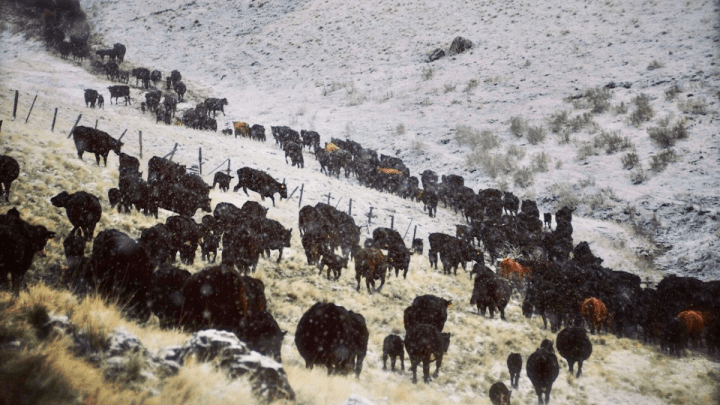
For Western ranchers, harsh weather has meant brutal losses during prime calving season
For Western ranchers, harsh weather has meant brutal losses during prime calving season

In remote southeast Oregon, about the only place to stop for a hundred miles is the Oasis Cafe in Juntura.
Travelers come in for coffee and to warm up near the wood stove. Locals gather here too.
Rancher Glenn Harris sits down with a couple of his neighbors for a hot burger. He’s talking about what everyone’s talking about right now: How this bitter spring has been devastating for newborn calves.
“We had about two feet of snow at least on top of five or six inches of ice,” Harris said. “Those calves are born and they just melt right down to that ice.”
Atmospheric rivers poured down on the West Coast this winter and hit California hard, then traveled east blasting snow and ice across Idaho, Montana and the Dakotas. For ranchers, that unrelenting weather has stretched into spring and caused a challenging calving season. Newborn calves have been dying because of the cold across much of the West and Midwest. Because calves are born wet they have to get dry, get a drink of milk, and warm up quickly. And the brutal weather has made that tough.
Fresh calves
Usually, a cow or heifer gives birth all on her own. Ranchers will find her calf sometimes days later — and that’s no problem. But during blizzards, ranchers have to be out every hour looking for fresh calves.
“And if you’re not right there, you’re gonna lose ‘em,” Harris said.
The calves can go from about 100 degrees in the womb to zero, or minus 10 with wind. Their wet coats don’t help.

Harris says this year, he’s lost around 35 calves and another 25 have frozen joints.
“I mean they can barely walk,” he said. “It’s just been a really tough year.”
Harris’ eyes glisten. He says he tried to save a young calf recently, “and he really wanted to live, but he just kept getting weaker and weaker … tubed him, and anyway, he didn’t make it, so yeah.”
Each calf can be worth around $1,200 come fall, so losing any is a big deal. Ranchers expect some loss, but this much is rare.
On some ranches in southeast Oregon, the losses have been particularly staggering. Several ranchers estimated that they’ve lost dozens of their calves to the cold. There’s no way of knowing the exact number killed — the USDA’s National Agricultural Statistics Service doesn’t count cattle during the spring — but all told, operators believe scores of calves may have perished across the Northwest, West, and Midwest.
In McAllister, Montana, Linda Owens has a cow-calf business and has spent a lot of the winter shoveling snow.
“My shovel is very tired,” she said, “and I’m going to have to get a new one.”
Some of her neighbors had to put down horses that slipped on ice; Owens says this cold has been rough. She runs a special program for ranchers and county residents to compost dead livestock.
“Digging myself out — my tractor, my pickup trying to go out and get carcasses off the landscape,” Owens said.
Down herd, prices up
All of these calf deaths are hitting the beef market hard. Nationwide, herd numbers were already down because of drought. So, prices are up. Lane Broadbent is with KIS Futures in Oklahoma City.
“We just continue to have record high prices, but we’ve got such extremely tight supplies of cattle available to kill,” he said.
And cattle can’t be raised to kill just overnight. That means that beef prices might stay high for years.
In Kimball, South Dakota, Colby Olson moves the calves away from the feed wagon as his wife drives the tractor. On snow days, his kids pitch in. They help number and match calves to their mothers.
“The kids, they called off school,” Olson said. “So I was picking up calves and throwing them in the back seat of the pickup. And I’d say, ‘OK put a scarf on that calf and remember he’s number 707.’”
Olson said he’s bringing newborns into the house to dry them with his wife’s hairdryer.
The only bright spot for ranchers and cattle in all this: When all the snow melts, then comes the fresh grass.
There’s a lot happening in the world. Through it all, Marketplace is here for you.
You rely on Marketplace to break down the world’s events and tell you how it affects you in a fact-based, approachable way. We rely on your financial support to keep making that possible.
Your donation today powers the independent journalism that you rely on. For just $5/month, you can help sustain Marketplace so we can keep reporting on the things that matter to you.

















